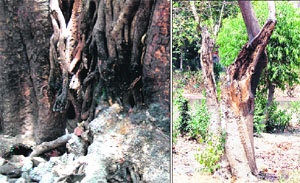Amritsar, Punjab: Even as the state government is spending quite significantly on landscaping and preserving the historic buildings at Ram Bagh, but no effort has been made to maintain the rare varieties of trees dating back to the nineteenth century.
Many rare trees at Ram Bagh, where the summer palace of Maharaja Ranjit Singh is located, are dying due in absence of treatment or burning of refuse around them.
Many rare trees which normally grow in the Himalayas and Nilgiri Hills are facing apathy of the Municipal Corporation.
A tree just outside Ram Bagh and opposite the residence of MC Commissioner which was burnt has fallen to the ground.
Burning of refuse at the bottom of trees has been highlighted in this newspaper but the authorities concerned have failed to take any action in this regard.
While traders are resorting to burning of trees on roadsides as they obstruct the view of their commercial establishments, the trees at the historic Ram Bagh Gardens are also facing the similar fate.
Spread over 84 acres of land, the garden came into existence in 1818 as the summer palace of Maharaja Ranjit Singh. However, today the flora of the garden is facing apathy of the authorities concerned.
INTACH member Dr Suresh Chohan said for the upkeep of these trees, a plan enlisting the names of rare trees, their benefits and the ways to preserve them was required. The similar plan was submitted to the Municipal Corporation about 10 years back but nothing concrete has come out.
The population of rats in the park has increased as people offer grains, pulses, jaggery and other eatables to birds and insects.
Referring to the old gingo biloba tree, he said it was used in making homoeopathic medicines.
Diospyrose cordifolia, commonly known as tendu, and akash neem are other trees used in preparing medicines.
MC Commissioner Bhupinder Singh said, “The issue of these rare trees has been brought to my notice. I will consult the Horticulture Department over the matter. The trees requiring treatment will be identified and will be given to the Horticulture Department.”
“The visitors will be educated not to throw eatables around these trees,” he added.
Source: The Tribune
 Sikh Sangat News Celebrating Sikh culture and sharing Sikh voices
Sikh Sangat News Celebrating Sikh culture and sharing Sikh voices

